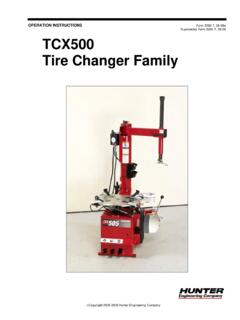Transcription of DFMA = Design for Assembly + Manufacturing
1 DFMA = Design for Assembly + Manufacturing by Bob Warfield What is DFMA ( Design for Manufacturing and Assembly )? DFMA stands for Design for Manufacture and Assembly also Design for Manufacturing and Assembly . It consists of two sub-methologies: DFA: Design for Assembly DFM: Design for Manufacturing It s purpose is to reduce costs by making changes during the Design phase. As such, it is considered part of lean Manufacturing . DFMA is also a registered trademark of Boothroyd Dewhurst, who use it as the name of their integrated set of software products. During the 1970 s, University of Massachusetts Professor Geoffrey Boothroyd and colleagues did research that would eventually lead to DFMA. One of their important findings was that the then-prevalent wisdom of minimizing the complex of individual parts to reduce the cost to manufacture was often not the best approach. In 1980, Dr peter Dewhurst joined Dr Boothroyd to create the first commercial DFMA software package, which ran on Apple II s.
2 DFMA basics Video Here s a video from my monthly CNC Chef series for Cutting Tool engineering : Design for Manufacturing and Assembly from Cutting Tool engineering on Vimeo. Critical Insight: Save Costs at Design Time The biggest insight of the DFMA process is that most of the available cost savings are at Design Time. It s not hard to understand why making changes to CAD drawings is a lot cheaper than changing a Manufacturing Assembly line that s all tooled up. That s probably an over simplification of all that s involved, but you get the idea. The Design Office to Shop Floor Communication Loop In the early days of Manufacturing , the designers were in close proximity to the Shop Floor where parts were being manufactured. They heard about problems in Manufacturing quickly and could easily visit the Shop Floor to see things firsthand. As such, a formal process and methodology were not as important.
3 As modern supply chains evolved, that communication loop between the Design Office and Shop Floor became increasingly strained. Job Shops moved the shop floor to another company entirely that was across town in the best case and across the country in the worst. Offshoring moved the Shop Floor even further away and added language and cultural barriers as well. Faced with those challenges, communication between the Design Office and Shop Floor broke down. A formal process was needed, and that process is DFMA. DFMA Can Help Job Shops Add Value While traditional DFMA is intended to be practiced at the Design Office, it need not be done exclusively there. Job Shops and Shop Floor personnel may have DFMA insights too. In fact, telling prospective customers ideas to reduce Manufacturing costs during the bidding process is an ideal way for Job Shops to add value and impress prospective customers. Who wouldn t want a Job Shop to provide valuable insight into how to reduce Manufacturing costs?
4 DFMA ( Design for Manufacturing and Assembly ) Examples Let s start with a process. DFMA is typically done DFA first and then DFM second. It s done in this order because one of the main tenets of DFA ( Design for Assembly ) is to reduce the number of parts as much as possible. There s no sense optimizing the manufacture of parts we eliminate during DFA! Let s drill down and see some DFA and DFM Examples. Design for Assembly Examples DFA ( Design for Assembly ) is all about reducing the number of parts that must be manufactured and reducing the cost to assemble the parts into a finished product. To reduce the number of parts, try to combine parts. Two parts can be combined if they meet the following conditions: They don t move relative to one another. They can be made of the same material and still meet the part s functional requirements. Once you ve successfully minimized the number of parts in a Design , it s time to make it cheaper and easier to assemble the parts.
5 An important principle is to Design symmetrical parts that will fit regardless of orientation. That way the assembler can t make a mistake with the wrong orientation and doesn t even have to think about orientation. Symmetry is just one subset of the lean Manufacturing Poka-Yoke concept, which is aimed at mistake proofing. Another tenet of Design for Assembly / DFA is to reduce fasteners and use less expensive fasteners. On average, fasteners are 5% of overall part cost but can be as much as 70% of the cost to assemble a part! Here s an example of preferred fastening methods to reduce costs: Here s a good example of the before and after of a DFA process for a part: Notice how many fewer components are on the right. A good benchmark is that a typical DFA process can reduce Manufacturing costs by 25%. Design for Manufacturing Examples Having minimized the number of parts needed through DFA as well as making Assembly easier and cheaper, it s time to look at the cost to manufacture each individual part.
6 That s the role of DFM or Design for Manufacturing . There are basically 4 steps needed in DFM: 1. Pick the best process. Should your part be cast, sheet metal fabbed, CNC Machined, or? 2. Pick the best material. What s the cheapest material in all respects (easy to work with in the chosen process is a factor) for the part? 3. Tolerances: What are the absolute minimum number of Tolerances with the widest allowable variance that will allow the part to function properly? 4. Optimize the Process: Investigate changes to particular aspects of geometry and part features to reduce costs. Pretty straightforward, but there s a fair bit of work to getting DFM right because it is so comprehensive. I will leave the choice of process and material for other articles, but I do want to talk about those last 2 steps. The High Cost of Tolerances Most designers are shocked when they learn how expensive too tight tolerances can be.
7 Here s a simple chart that makes the point: It s taken from our more comprehensive article, The High Cost of Tolerances, but you get the idea. I have two takeaways for you about Tolerances: 1. Don t over tolerance parts! 2. Use GD&T instead of simple +/- tolerancing. GD&T (Geometric Dimensioning and Tolerancing) is a more modern way of expressing tolerances than simple +/- tolerancing. It can allow you to keep tolerances tight enough for part function while providing wiggle room that won t matter to function but saves cost. I highly recommend our free GD&T Training if you re not familiar with it: [ Check out the Free CNCC ookbook GD&T Course today! ] Design for Manufacturing Principles and Guidelines So, you ve got Process, Materials, and Tolerances under control. It s time to take the final step by optimizing the part s geometry and certain features to minimize Manufacturing costs further. Here s our giant list of DFM Principles and Guidelines to help: Material Shape Consider which shapes are cheaper to acquire versus which shapes are closer to the finished part and hence require less machining to complete.
8 Bar stock can often be had for 1/2 the cost of plate for a given material, but you can waterjet more parts out of a plate. It ll take some careful calculations to tell which is cheaper to manufacture. If volumes are large enough castings or extrusions may further reduce machining time. Material Size When deciding your part s dimensions, visualize how they will interact with the rough stock sizes that are available. You need an allowance for machining that doesn t require too much step up in rough stock size lest you waste the time and material cost of turning that extra stock into chips. Rough Stock Preparation The cheapest form of material removal often comes at the rough stock preparation stage. For example, if you can start machining operations on a waterjet cut blank, you may only need one pass instead of a bunch of roughing passes followed by a finish pass. Keep Tolerances Loose The tighter the tolerances, the higher the Manufacturing costs.
9 Don t specify tight tolerances unless they re really needed. One of the most expensive tolerances is thread depth, and it often doesn t matter. Specifying thread depth to three decimal places is seldom going to accomplish much other than driving up costs substantially. More on the cost of tight tolerances. Depth of Cut vs Radius of Corners You can t cut a tight corner radius with a tool whose diameter is more than twice the corner radius. At the same time, the stiffness of a tool changes with the third power of length and the fourth power of diameter. Making the tool twice as long makes it 1/8 as rigid. Making the tool twice the diameter makes it 16x more rigid. Therefore, avoid designing parts with tight radius corners that are very deep. A good guideline is keep the ratio to 3:1 depth vs diameter (2x corner radius). So, a pocket with a 1/4 corner radius should be no more than deep or you ll greatly increase the Manufacturing costs.
10 Here s another tip: choose a corner radius just slightly larger than the endmill radius that will be used to make the corner. This reduces the loads on the endmill due to lower tool engagement angles in the corner and will reduce your Manufacturing costs as a result either by allowing the endmill to be fed faster or by causing it to last longer. Through Holes and Deep Holes Where possible, specify through holes as they facilitate chip evacuation. This is particularly important on holes that will be reamed or threaded. Deep holes are also much more expensive to manufacture. Try to keep the ratio of length to diameter under 4 (no holes more than 4 diameters deep) for best results. Any hole over 10 diameters deep is likely to be problematic, there are tools like G-Wizard s Deep Hole Wizard to help. Edge Preparation It s generally cheaper to chamfer an edge than to radius the edge. Avoid Mirror Image Parts Mirror image parts are generally used in pairs in an Assembly .






